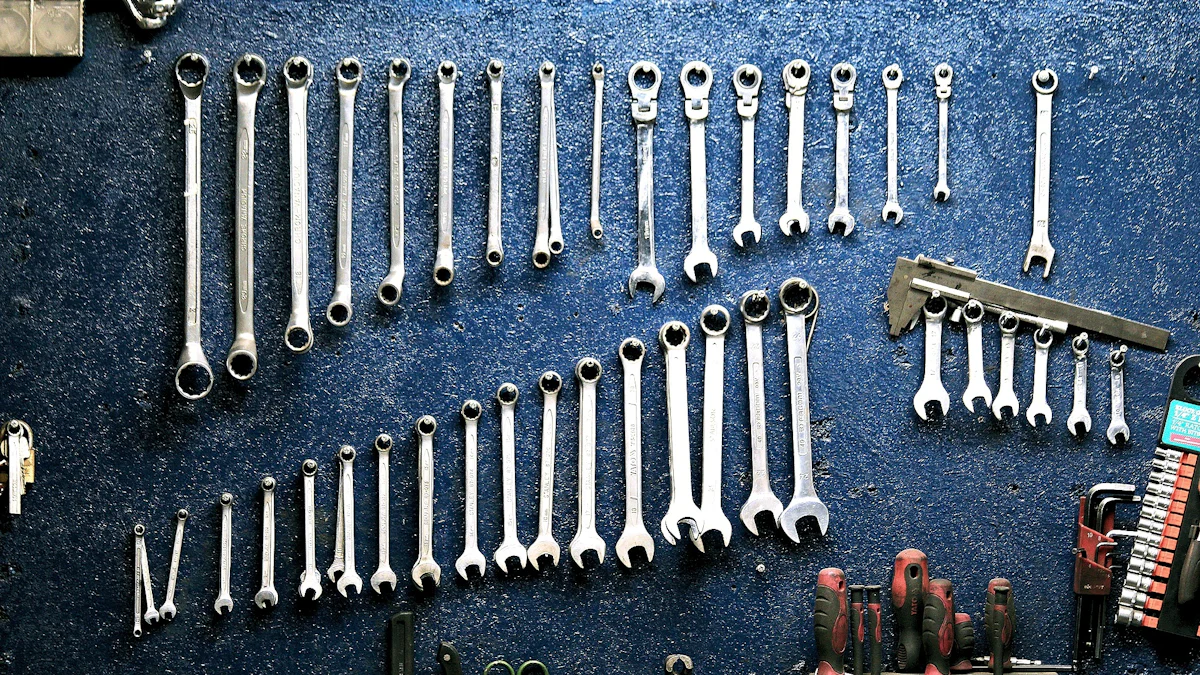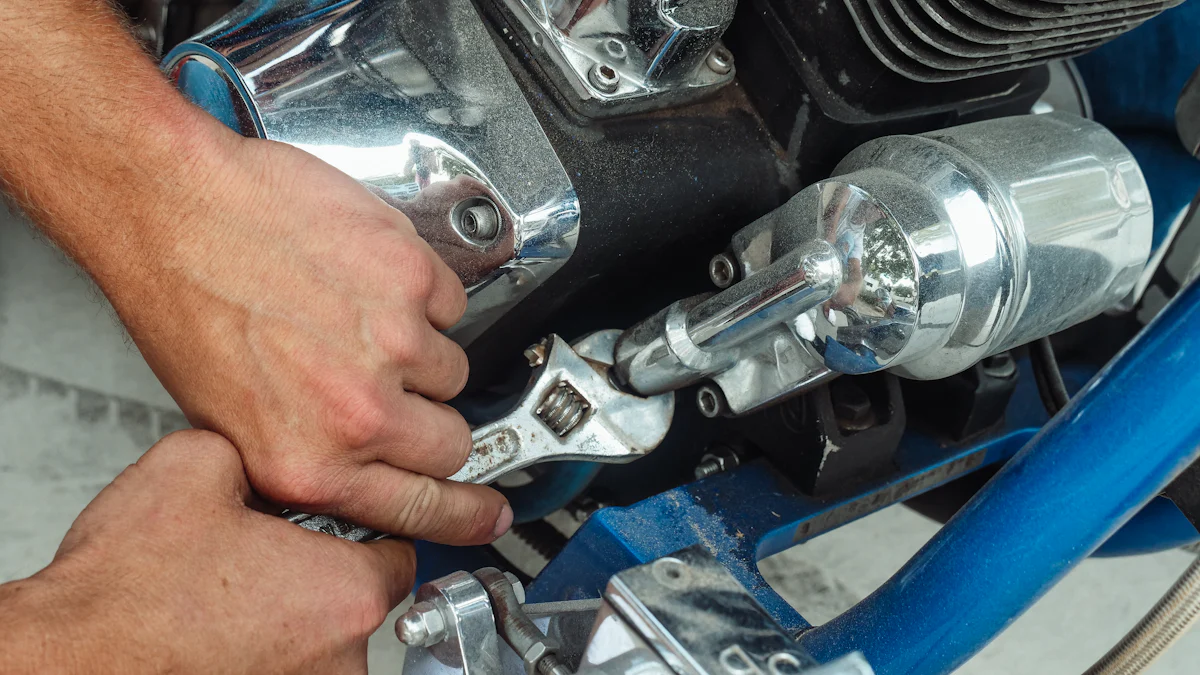
Car Exhaust Manifold: Engine exhaust manifold plays a crucial role in channeling exhaust gases from the combustion chamber into the exhaust tubes. It not only enhances engine output and fuel efficiency but also boosts overall car performance. Upgrading to an aftermarket ford 300 exhaust manifold can significantly improve your vehicle’s performance by replacing the susceptible cast iron stock manifold prone to cracking due to thermal stress.
Tools and Preparation

Required Tools
Wrenches and Sockets
- Utilize a 1/4″ socket set for efficient removal and installation of bolts.
- Ensure the tab surfaces are clean and free from debris to prevent any interference during the process.
- Use spanner washers to securely fasten the manifold components.
Torque Wrench
- Employ a torque wrench to accurately tighten the bolts as per the manufacturer’s specifications.
- Adjust the torque settings as required for different sections of the exhaust manifold.
Safety Gear
- Prioritize safety by wearing appropriate gear such as gloves, goggles, and protective clothing.
- Maintain a clean and organized workspace to minimize accidents during the replacement procedure.
Preparation Steps
Safety Precautions
- Before initiating any work, disconnect the vehicle’s battery to prevent electrical mishaps.
- Keep fire extinguishing equipment nearby in case of unexpected combustion situations.
Vehicle Setup
- Position the vehicle on a level surface to ensure stability while working on the exhaust system.
- Use wheel chocks to secure the wheels and prevent any unintended movement during the replacement process.
Inspection of the New Exhaust Manifold
- Examine exhaust manifold thoroughly for any signs of damage or defects before installation.
- Verify that all necessary components, including gaskets and mounting hardware, are included in the package.
By following these meticulous preparation steps and utilizing essential tools, you can streamline the process of replacing your Ford 300 exhaust manifold effectively.
Removal Process

Accessing the Exhaust Manifold
When preparing to access the Ford 300 exhaust manifold, it is essential to start by removing the air intake system. This step involves carefully disconnecting and detaching the air intake components from the manifold assembly. By loosening and removing the necessary bolts and clamps, you can create ample space to proceed with the removal process effectively.
After successfully addressing the air intake system, the next critical task is disconnecting the vehicle’s battery. This precautionary measure ensures a safe working environment by eliminating any electrical hazards during the removal of the old exhaust manifold. By disconnecting the battery, you minimize potential risks and enhance overall safety throughout the maintenance procedure.
Removing the Old Exhaust Manifold
To begin removing the old ford 300 exhaust manifold, focus on unbolting it from its current position. Utilize appropriate tools such as wrenches and sockets to loosen and detach all securing bolts holding the manifold in place. By systematically working through each bolt, you can gradually release and free up the manifold for extraction.
Once all bolts are removed, proceed to take out the gasket situated between the exhaust manifold and engine block. Carefully extract this component to ensure a clean separation between the old manifold and its mounting surface. Removing the gasket effectively paves the way for seamless installation of a new exhaust manifold without any residual elements hindering performance.
With both the bolts and gasket removed, shift your focus towards cleaning the mounting surface where the old exhaust manifold was situated. Thoroughly inspect this area for any debris or remnants that could impact proper alignment or installation of a replacement ford 300 exhaust manifold. By meticulously cleaning and preparing this surface, you set a solid foundation for installing a new component that functions optimally within your vehicle’s engine system.
By following these systematic steps in accessing and removing your Ford 300 exhaust manifold, you pave the way for a successful replacement process that enhances your vehicle’s performance and reliability.
Installation Process
Installing the New Exhaust Manifold
To commence the installation process of the Engine exhaust manifold, position the new manifold precisely in alignment with the designated mounting points on the engine block. Ensuring accurate placement of the manifold is crucial for optimal performance and seamless integration within the vehicle’s exhaust system.
Next, proceed to bolt down the new Engine exhaust manifold securely using the appropriate tools. Tighten each bolt uniformly and firmly to establish a robust connection between the manifold and the engine block. Adequate bolting guarantees stability and prevents any potential issues related to loose components during vehicle operation.
Subsequently, install the new gasket between the freshly positioned Engine exhaust manifold and the engine block. The gasket serves as a vital sealing component that prevents gas leakage and ensures efficient channeling of exhaust gases through the system. Proper installation of this gasket is essential for maintaining airtight integrity within the exhaust assembly.
Finalizing the Installation
Upon successfully installing the new Engine exhaust manifold, reconnecting the vehicle’s battery is imperative to restore power supply and enable electronic functionalities within your car. Reestablishing this connection safeguards against electrical malfunctions and ensures smooth operation of various systems dependent on battery power.
Following battery reconnection, reinstalling the air intake components completes the installation process of your Ford 300 Exhaust Manifold. Carefully attach each part back into its original position, securing them firmly to prevent dislodgment or interference with surrounding elements. Proper reinstallation guarantees optimal airflow and functionality of your vehicle’s intake system.
To conclude, conduct a thorough inspection to check for any potential leaks in the newly installed Ford 300 Exhaust Manifold. Carefully examine all connection points, including bolts, gaskets, and joints, to identify any signs of gas seepage or irregularities. Addressing leaks promptly ensures proper functioning of your exhaust system and prevents performance issues down the line.
Final Tips and Troubleshooting
Common Issues
Misalignment Problems
When the Ford 300 exhaust manifold is not correctly aligned during installation, it can lead to performance issues and potential leaks. To avoid misalignment problems, ensure that the new manifold aligns precisely with the mounting points on the engine block. Proper alignment guarantees optimal functionality and prevents any disruptions in the exhaust system’s operation.
Gasket Issues
Issues with gaskets can compromise the sealing integrity of the Ford 300 exhaust manifold, resulting in gas leaks and inefficiencies. To address gasket problems, carefully inspect the quality and positioning of the gasket during installation. Ensure that the gasket forms a tight seal between the manifold and engine block to prevent any gas leakage. Regularly checking and maintaining gaskets can significantly enhance the longevity and performance of your exhaust system.
Maintenance Tips
Regular Inspections
Performing routine inspections on your Ford 300 exhaust manifold is crucial for identifying potential issues early on and ensuring optimal performance. Regularly check for signs of wear, damage, or leaks in the manifold components. Inspecting bolts, gaskets, and mounting surfaces can help detect any abnormalities that may affect the exhaust system’s efficiency. By conducting periodic assessments, you can proactively address minor concerns before they escalate into major problems.
Proper Torque Settings
Maintaining proper torque settings when installing or tightening bolts on your Ford 300 exhaust manifold is essential for secure connections and reliable performance. Refer to manufacturer specifications for recommended torque values and apply them accurately during installation. Over-tightening or under-tightening bolts can lead to issues such as leaks or component failure. Adhering to correct torque settings ensures that all components are securely fastened, promoting efficient operation of your exhaust system.
By addressing common misalignment and gasket issues while implementing regular inspections and adhering to proper torque settings, you can optimize the functionality and longevity of your Ford 300 exhaust manifold. These maintenance tips will help you maintain a well-performing exhaust system that enhances your vehicle’s overall reliability and performance over time.
- To ensure trouble-free service and extend engine life, regular maintenance and seeking professional help are crucial.
- Following the correct setup and techniques using machine-grade tooling and proper drilling methods can ensure a productive repair process.
- Quick action on burning smells and gasket problems can reduce damage, prevent further issues, and provide peace of mind.
Post time: Jun-11-2024



